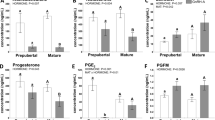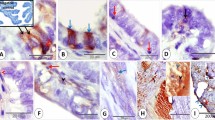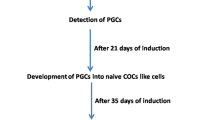Abstract
IN humans, a gonadotrophin (hCG) is localised on the cell membrane of the syncytiotrophoblast facing the maternal bloodstream1. The syncytiotrophoblast is derived from the trophoblast cells of the mammalian blastocyst and is thought to participate in isolating the foetus from attack by the maternal immunological system2. Martin, et al.1 suggest that the hCG on human syncytial plasma membranes may, in part, be responsible for the lack of maternal immunological rejection of the foetus; in addition to its role in steroidogenesis, therefore, hCG may also have an immunological function during pregnancy. Because hCG is generally used to induce super-ovulation in mice and must, therefore, cross-react with mouse gonadotrophin, and since the mouse is extensively used in studies on mammalian development, I investigated the possible presence of gonadotrophin(s) in mouse embryos before implantation and formation of the syncytiotrophoblast. Using an antiserum to hCG and indirect immunofluorescence (IIF) I have detected a luteinising hormone (LH)- or hCG-like substance (‘embryonic gonadotrophin’, EG) on the cell surfaces, of live mouse preimplanted embryos.
This is a preview of subscription content, access via your institution
Access options
Subscribe to this journal
Receive 51 print issues and online access
$199.00 per year
only $3.90 per issue
Buy this article
- Purchase on Springer Link
- Instant access to full article PDF
Prices may be subject to local taxes which are calculated during checkout
Similar content being viewed by others
References
Martin, B. J., Spicer, S. S., and Smythe, N. M., Anat. Rec., 178, 769–786 (1974).
Vandeputte, M., and Sobis, M., Transplantation, 14, 331–338 (1972).
Gates, A. H., in Methods in Mammalian Embryology (edit. by Daniel, J. C, jun.), 64–75 (Freeman, San Francisco, 1971).
Rafferty, K. A., jun., in Methods in Experimental Embryology of the Mouse, 24–34 (Johns Hopkins Press, Baltimore, 1970).
Biggers, J. D., Whitten, W. K., Whittingham, D. G., in Mammalian Embryology (edit. by Daniel, J. C., jun.), 86–116 (Freeman, San Francisco, 1971).
Glass, L. E., in Methods in Mammalian Embryology (edit. by Daniel, J. C., jun.), 355–377 (Freeman, San Francisco, 1971).
Haour, F., and Saxena, B. B., Science, 185, 444–445 (1974).
Fugimoto, S., Woody, H. D., and Dukelow, W. R., Fedn Proc., 32, 214 (1973).
Braunstein, G. D., Grodin, J. M., Vaitukaitis, J., and Ross, G. T., Am. J. Obstet. Gynecol., 115, 447–450 (1973).
Adcock, E. W., III, Teasdale, F., August, G. S., Cox, S., Meschia, G., Battaglis, F. C., and Naughton, M. A., Science, 181, 845–847 (1973).
Robison, G. A., Butcher, R. W., and Sutherland, E. W., A. Rev. Biochem., 37, 149–174 (1968).
Danzo, B. J., Biochim. biophys. Acta, 304, 560–569 (1973).
Dickman, Z., and Dey, S. K., J. Reprod. Fert., 37, 91–93 (1974).
Huff, R. L., and Eik-New, K. B., J. Reprod. Fert., 11, 57–63 (1966).
Author information
Authors and Affiliations
Rights and permissions
About this article
Cite this article
WILEY, L. Presence of a gonadotrophin on the surface of preimplanted mouse embryos. Nature 252, 715–716 (1974). https://doi.org/10.1038/252715a0
Received:
Revised:
Issue Date:
DOI: https://doi.org/10.1038/252715a0
This article is cited by
Comments
By submitting a comment you agree to abide by our Terms and Community Guidelines. If you find something abusive or that does not comply with our terms or guidelines please flag it as inappropriate.



